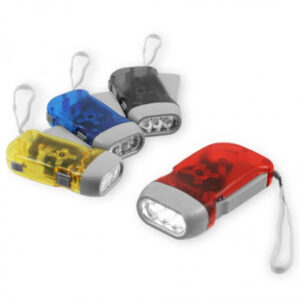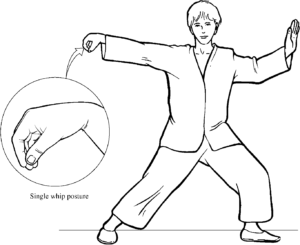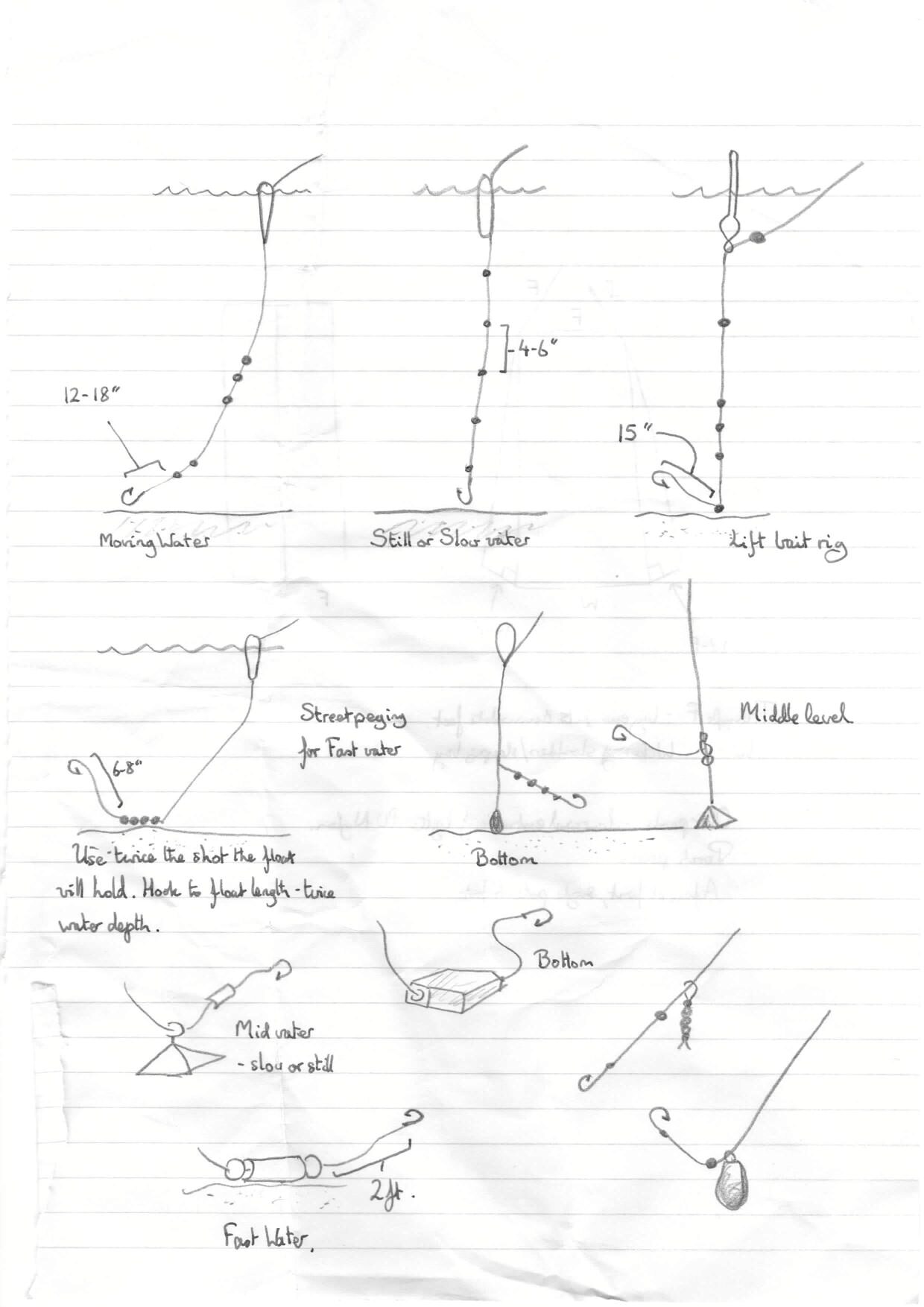Fishing Methods
Passive fishing is to set up a rig and leave it unattended although there's no reason why you can't sit and watch it if you like.
The most common way to do this is to set up what is termed a “nightline”.
As the name suggests, this can be left overnight and any catch collected in the morning, which is useful if you spend the daylight travelling to safety.
There's no reason why you can't rig up a nightline during the day, of course.
It's a good idea to check the line several times during the night, since some beasts such as frogs and turtles can break free if left long enough.
Attach one end of the line to the bank and the other to a weight, and attach leaders with baited hooks at intervals along the line.
Throw the weighted end into the water. This is easier if you use a forked stick since it prevents getting caught by your own hooks.
Drive a stick with a notched top between the water and the anchor point on the bank and run the line over the top. Movement of this stick will show something is hooked. Placing a pebble or chunk of mud on top of the stick provides further visual clues: if it has dropped off, you've caught something!
Alternately, run the line over the water between two points, like a washing line with the baits suspended at different depths.
An improvised bell (empty tin can) can be used to signal a catch.
Vary the baits and take note of which ones seem to be taken most often.
You can also hang lines from branches overhanging the water.
Active Fishing
Active fishing involves you holding onto the line and sometimes actively moving the bait or lure.
Such fishing prevents you from doing anything else, so is best considered if you have to remain in the same location, such as near a crash or a broken down vehicle, or are with a companion who can't travel.
Active fishing and other methods will be described in following blogs.
******************************************************
I never did get around to posting the second part of this article!
Rather than have the two parts separated by hundreds of other posts, I have decided to add the rest of the chapter below.
Some of my ideas on the topic of survival fishing have evolved in the decades since I originally wrote this. I think many survival manuals and kits put too much of an emphasis on active fishing with a line.
See my post on trot lines (coming soon!).
Part Two
Active Fishing
Active fishing involves you holding onto the line and sometimes actively moving the bait or lure. Such fishing prevents you from doing anything else, so is best considered if you have to remain in the same location, such as near a crash or a broken down vehicle, or are with a companion who can't travel.
In the fishing kit detailed above, you use a hook to nylon attached by the swivel to the braided line, or a wire trace with a hook on the end attached to the braided line if you are after sharp toothed prey, such as pike or turtle.
A nice thing about braided line is it is a lot less fiddly to tie when you're cold and tired. You have several hooks, so there's nothing to stop you placing several traces on the handline, so you can vary the bait or depth you are fishing at.
The most basic method of angling is to put your bait on a hook and line and just dangle the bait in the water.
Some bait will float on the water, such as an artificial fly or lump of bread and will be taken by surface feeders. If the bait sinks, it will be taken by fish that feed at the level the bait stops at. You can control this by adding weights. That's it really.
Spinning
Spinning is done with lures or any bait that is highly visible.
What you're doing is pulling the lure through the water to make the fish think that the moving bait is a swimming fish. The line is lightly shotted, just enough to take it down to a depth predatory fish may be at.
Cast your line as far as you can, or beyond were you suspect fish, then reel it back in, passing any reeds where predators like to hide, and pausing occasionally: fish seem to like a jerking progress.
In fast moving water the lure may appear active enough without you reeling it in.
This method is a lot easier with an improvised reel: usually a stick or some other object you can wind the line around as you take it in.
A “classic” improvised reel is a tin can, a plastic bottle or similar on a stick. The line slips quite easily from its large diameter, so it can be used as a casting aid.
Attach the other end to the stick, or better still your belt in case your hand slips.
You can also throw out your line as one would a grappling hook, fire it by catapult etc.
Ledgering
Ledgering uses a weight at one end of the rig.
When using a rod, the weight may hang in free water but when using a handline it will usually rest on the bottom unless you are directly above where you are fishing. The diagrams illustrate several ledgering rigs for different waters.
When using survival fishing kits, it can be confusing as to where the large weight comes from.
One answer is the link ledger weight illustrated, which is a piece of line and several BB split shot.
Or you can use lead or stones in a piece of leaf, woven grass, hide or cloth. Some stones can be tied to the line directly with a Killick hitch.
The film canister used to carry the kit can be packed with earth or gravel and used as a weight.
Steel or brass washers have also been used as weights, and have the advantage they are relatively compact and will fit nicely into some fishing kit containers.
Float Fishing
A float is a buoy to suspend your rig from and also acts as a visual signal of a bite.
Just as anything that sinks and will remain attached to the line can be a weight, so anything that floats and stays attached can be used as a float.
The film canister can be taped or tied to the line. So can twigs, feather quills, porcupine spines, bits of polystyrene cups, inflated condoms etc.
A floating branch can support several lines.
Coloured tape can be added to floats so they are more visible.
Fly Fishing
You can do this with or without a rod.
Flies can be made from thread (frayed cloth from clothing), fur, feathers and hair, so can be field improvised.
You can use real insects too: anything that will sit on or float in the surface layer of water.
Think of when you used to play in the paddling pool on sunny days and insects would land in the water.
Remember the weird shadows they created on the pool bottom? Dark ovals outlined with silver?
This is because they deform the surface layer of the water, refocusing the light. This is really visible to fish under the water, who know this means something edible.
For fly fishing, don't shot the line and use a monofilament trace. The braided line will be too heavy.
Greasing the line so that it floats may be advisable since we won't be using special fly trace.
Best place to fly fish is where you can see real flies and fish disturbing the surface of the water to take them.
Try to imitate the flitting motions of the flies.
Bait
Fish will take artificial bait such as flies, lures, feathers and bits of wool or shiny metal.
Worms are not as common in some environments as you might expect, so often your best bet is to split open a rotting log and take your pick of the grubs and beetles you find.
Caterpillars are also easy to catch.
Bits of entrails from a previous catch or an animal you've trapped are good too.
In both cases you're turning something you probably don't want to eat into something you do.
Many fish are quite fond of berries, so when in season these should not be overlooked as bait.
[When I was originally writing this, there was a story in the press that fishermen were finding that female pubic hair was an excellent bait. This is supposedly something to do with the oestrogen so it needs to be fairly recently “collected” and isn't something you can keep in your kit till needed. Some of you reading will have a ready supply, so I'll pass the idea on though I can't testify to if this really works. If someone manages to get a meal out of this bait, maybe they'll let me know.]
The above all turned out to be bogus newspaper BS, but pubic hair (male, female or preferred identification) may be a useful material for making fishing flies.)
Rod Fishing
Dave (my intended co-author) is a far keener fisherman than I and uses the following rig for passive and active fishing.
In addition to hooks and spinners, this requires tape, a spool of line and a 4" piece of coat hanger wire or large paper clip.
Dave has used such a rig often, though being a Signalman his “rod” was often the antennae of a land rover.
If possible select and cut a length of sapling/wood for the use of a rod approx. 8 to 9 ft in length and inch to inch half in diameter.
With the wire, fashion a loop at the top end and secure this with your tape and short piece of line. Then attach the reel to the other end***(diagrams were to explain and show how)*** Now run the line through the loop and attach a hook to the end with a weight attached, Hey presto, you a ready for the off to go fishing!!
A rod needn't have eyelets and a reel.
The roach pole is a long pole used for float fishing with a fixed length of line attached to its tip, usually up to half the length of the pole.
This setup needs a little “give” to absorb the energy of a strike, and this is done either by the springiness of the rod or by including a section of rubber band in the trace. A couple of rubber bands can be used to hold together some of the items above. Or you can use knicker elastic.
The trick to using the roach pole is to always keep the tip over the float.
An improvised tenkara rod is another possibility. In Bushcraft 101 by Dave Canterbury, a “lillian braid” for a tenkara rod made from the mantle of some paracord is suggested. The “lillian braid” is how the rigging is attached to the rod.
Dave's Fishing Kit
Dave suggests the following as a kit suitable for carrying in a backpack, and suitable for both survival and recreation fishing.
1. 50 metres of line (10 to 15 lbs)
2. 3x Mepps (small spinners)
3. 1x container of split shot (assortment or BB)
4. 4 inch piece of coat hanger wire or large paperlips.
5. Packet of size 12 hook to nylon
6. 3 small traces
7. An assortment of other hooks large and small (loose)
8. 3 treble hooks about size 12: used for live bait.
This equipment to be packed into 35mm photographic containers and bound together with electrical tape (1 metre).
There are several options with this kit.
If you are going to carry 50 metres of monofilament line you might as well carry the spool you brought it on.
Loose hooks and maybe spinners can be taped to the side of the spool if desired.
Gluing a small length of dowel to the spool will help in using it as a reel.
Sea Fishing
For sea fishing, other elements come into play such as tides and conditions.
If one is going to be near the coast then you must be prepared for this eventuality.
By this, I mean carrying stronger lines up to 30 lbs test, larger hooks and swivels.
Weights pose their own problems but these can be substituted by stones from the beach.
Methods vary somewhat to those of freshwater fishing by using the tides.
Wait till low tide, wade out and lay a long line of baited hooks. Leave them secured to the bottom and return after the tide has come and gone and see what you have caught (Not very labour intensive!)
Fishing Kits for Life Rafts and Ditch Kits
Fishing is obviously one of the main ways to get food if in a life raft, but the kits often supplied are insufficient in both quality and quantity.
If you hook a big fish such as a shark, your safest option may be to cut line, rather than try to get it in the raft and kill it.
You may also have to rely on this kit for months, so plenty of spares make sense. So too does the extra expense of stainless steel hooks.
Another thing that is often lacking from kits but will prove useful is some form of winder, such as those used for kites.
400 ft. – Monofilament Fishing Line, 20 lb. test
36+ – Barbed Hooks, size 2/0
36+ – Barbed Hooks, size 2
24+ – Barbed Hooks, size 6
6 – Barbed Treble Hooks, size 1
6 – Barbed Treble Hooks, size 6
6 – Barbed Treble Hooks, size 8 or 10
24 – Nylon Leaders w/ Snap Swivels, 10-12 inch
12 – Wire Leaders w/ Snap Swivels, 8 inch
24 – Snap Swivels
24 – Assorted Sinkers
12 – Chrome Spoons and Lures
3 – Straight Shank Hook, size 9/0 (for gaffing)
2 – Winders
1 – Waterproof Fishing Instruction Booklet including illustrations of fishing knots
Fishing Nets
A net or fish trap is often better than a line if you can make one.
An “instant” net is a lady's stocking or tights. A fish becomes easily entangled and damaged in these, so this is a survival only technique.
When she was living in Brazil, my girlfriend regularly fed herself by fishing. Her father was a fisherman who had worked on the ocean-going boats. Her father would fish with a handline, but my lady preferred a net.
The net she used she calls a “pulsá”. It was round and had hooks for bait in the centre. It sounds like a lift-net in form, but she used it by throwing it into the sea and then hauling it in, which sounds like a type of trawling.













